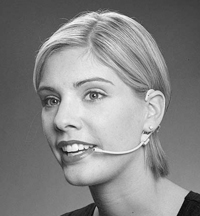
Headworn Microphones
Again, the desired sound source for a headworn microphone is a speaking or singing voice.
Undesired sources include other voices, instruments, ambient sound and sound system loudspeakers.
Most headworn microphones are of the condenser type because of their small size and superior sound quality. A dynamic type can be used for speech-only applications or if larger size is not an issue.
For either type, the frequency response is shaped for closeup vocal with some presence rise.
An omnidirectional polar pattern is suitable for most applications, especially if the microphone does not reach all the way in front of the mouth.
A unidirectional pickup is preferred in very high ambient noise applications or to control feedback from high volume monitor loudspeakers.
For proper operation, unidirectional types should be positioned in front of or directly at the side of the mouth and aimed at the mouth. A windscreen is a necessity for a unidirectional headworn microphone.
Balanced low-impedance output is preferred for hardwired setups but headworn types are often used in wireless applications. In that case, the impedance and wiring are made suitable for the wireless system.
For condenser types, the bodypack transmitter provides the necessary bias voltage for the microphone element.
There are many different headworn mounting designs. Most have a headband or wireframe that goes behind the head, while a few are small enough that they merely clip over the ear.

